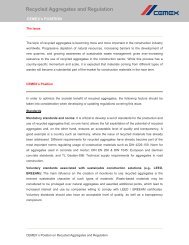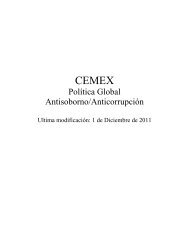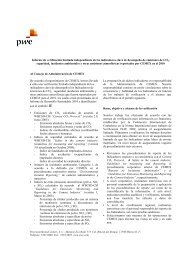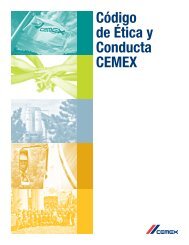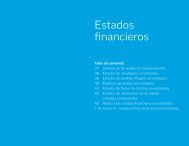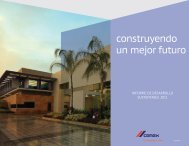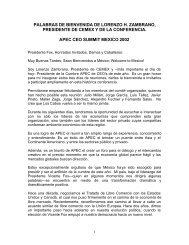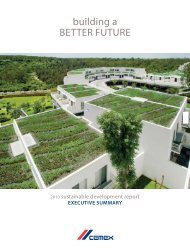building a STRONGER foundation - Cemex
building a STRONGER foundation - Cemex
building a STRONGER foundation - Cemex
Create successful ePaper yourself
Turn your PDF publications into a flip-book with our unique Google optimized e-Paper software.
S) OTHER EXPENSES, NET<br />
CEMEX, S.A.B. DE C.V. AND SUBSIDIARIES<br />
Notes to the Consolidated Financial Statements – (Continued)<br />
As of December 31, 2010, 2009 and 2008<br />
(Millions of Mexican pesos)<br />
The caption consists primarily of revenues and expenses not directly related to CEMEX’s main activity, or which are of an unusual or nonrecurring<br />
nature. Other expenses, net in 2010, 2009 and 2008, consisted of the following:<br />
2010 2009 2008<br />
Impairment losses (notes 8, 9B, 10 and 11)....................................................... Ps (1,904) (889) (21,125)<br />
Restructuring costs (note 13)............................................................................. (897) (1,100) (3,141)<br />
Charitable contributions .................................................................................... (385) (264) (174)<br />
Current and deferred ESPS (note 2M)............................................................... (5) (8) 2,283<br />
Results from the sale of assets and others, net................................................... (3,481) (3,268) 754<br />
Other expenses, net...................................................................................... Ps (6,672) (5,529) (21,403)<br />
T) EXECUTIVE STOCK-BASED COMPENSATION (note 17)<br />
Beginning in 2009, CEMEX applies MFRS D-8, “Share-based payments” (“MFRS D-8”), to recognize its executive stock-based<br />
compensation programs. Until 2008, CEMEX applied International Financial Reporting Standard 2, “Shared-based payments.” There were no<br />
effects from the adoption of MFRS D-8 in 2009.<br />
Stock awards based on CEMEX shares granted to executives are defined as equity instruments, when services received from employees are<br />
settled delivering CEMEX’s shares; or as liability instruments, when CEMEX commits to make cash payments to the executives on the<br />
exercise date of the awards based on changes in the CEMEX’s own stock (intrinsic value). The cost of equity instruments represents their<br />
estimated fair value at the date of grant and is recognized in the income statement during the period in which the exercise rights of the<br />
employees become vested. In respect of liability instruments, these instruments are valued at their estimated fair value at each reporting date,<br />
recognizing the changes in fair value through the income statement. CEMEX determines the estimated fair value of options using the<br />
binomial financial option-pricing model.<br />
U) EMISSION RIGHTS<br />
In some countries where CEMEX operates, such as member countries of the EU, governments have established mechanisms aimed to reduce<br />
carbon-dioxide emissions (“CO2”), by means of which, industries releasing CO2 must submit to the environmental authority at the end of a<br />
compliance period, emission rights for a volume equivalent to the tons of CO2 released. In addition, the United Nations Framework<br />
Convention on Climate Change (“UNFCCC”) grants Certified Emission Reductions (“CERs”) to qualified CO2 emission reduction projects.<br />
CERs may be used in specified proportions to settle emission rights obligations in the EU. CEMEX actively participates in the development<br />
of projects aimed to reduce CO2 emissions. Some of these projects have been awarded with CERs.<br />
In the absence of a MFRS or an IFRS that defines an accounting treatment for these schemes, CEMEX accounts for the effects associated<br />
with CO2 emission reduction mechanisms as follows:<br />
Emission rights granted by governments are not recognized in the balance sheet considering their cost is zero;<br />
Revenues from the sale of any surplus of emission rights are recognized decreasing cost of sales; in the case of forward sale transactions,<br />
revenues are recognized upon physical delivery of the emission certificates;<br />
Emission rights and/or CERs acquired to hedge current CO2 emissions are recognized as intangible assets at cost, and are further<br />
amortized to cost of sales during the compliance period; in the case of forward purchases, assets are recognized upon physical reception<br />
of the emission certificates;<br />
CEMEX accrues a provision against cost of sales when the estimated annual emissions of CO2 are expected to exceed the number of<br />
emission rights, net of any benefit obtained through swap transactions of emission rights for CERs;<br />
CERs received from the UNFCCC are recognized as intangible assets at their development cost, which are attributable mainly to legal<br />
expenses incurred with authorities in the process of obtaining such CERs; and<br />
CEMEX does not maintain emission rights, CERs and/or forward transactions for trading purposes.<br />
The combined effect of the use of alternate fuels that help reduce the emission of CO2 and the downturn in produced cement volumes in the<br />
EU, has generated a surplus of emission rights held over the estimated CO2 emissions. From the consolidated surplus of emission rights,<br />
during 2010, 2009 and 2008, CEMEX sold an aggregate amount of approximately 19.4 million certificates, receiving revenues of<br />
approximately Ps1,417, Ps961 and Ps3,666, respectively. As of December 31, 2010, there were forward sale commitments for approximately<br />
Ps319 with settlement in March 2011.<br />
F-17



